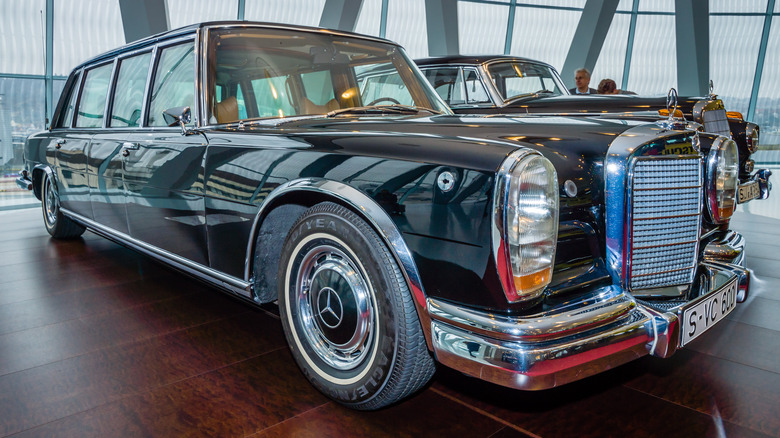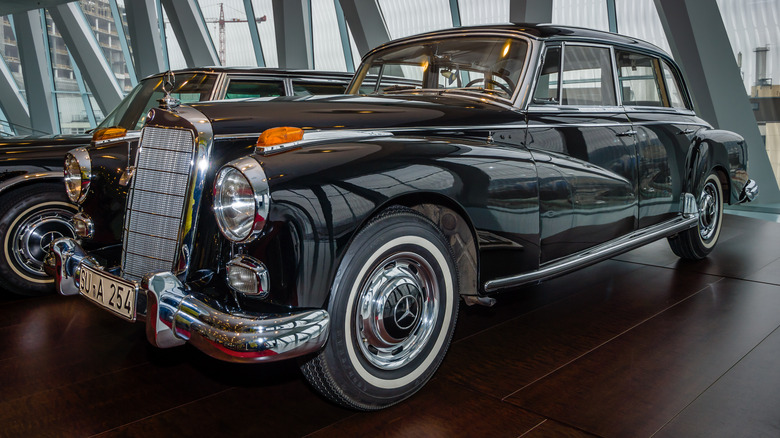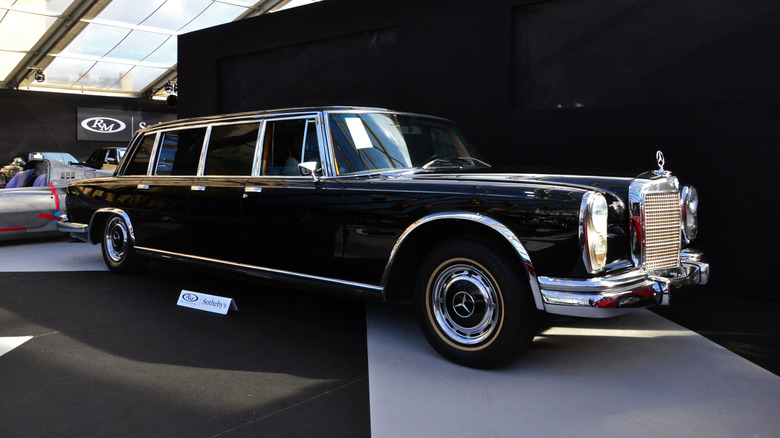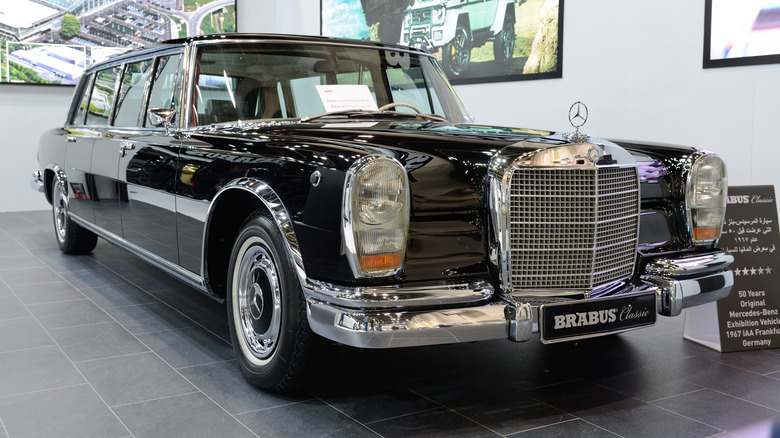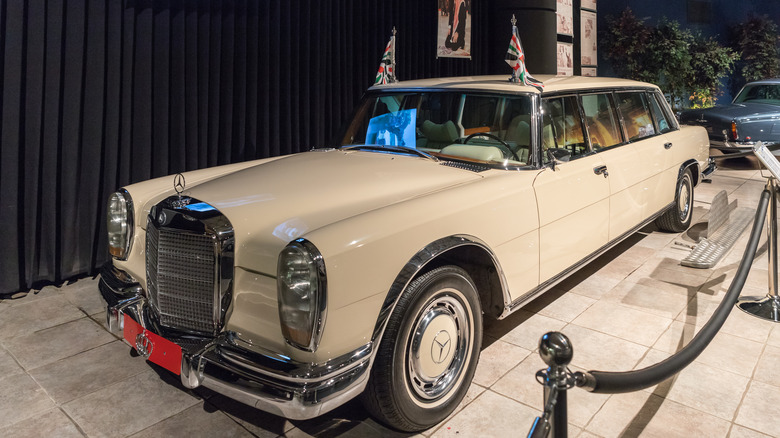Revolutionizing Luxury: The History Behind Mercedes' 600 Pullman
We may receive a commission on purchases made from links.
The very notion of a limousine has always been ostentatious. Heading down the street in a vehicle that takes up multiple car lengths demonstrates almost nothing other than a desire to parade your wealth to passers-by. Occasionally, there's a more practical reason for it, like packing a dozen teenagers into a stretch limo to go to their senior prom. But even then, it's still meant more to be a symbol of high-class extravagance, making those teenagers feel like the world is their oyster. Like most luxury items, limousines are status symbols.
Because of that connotation, luxury car companies that make limousines tend to go all-out when it comes to their design, and few limos make that point better than the one made by Mercedes-Benz from 1963 to 1981, the 600 Pullman. For those two decades, the German automaker had a vehicle that became almost shorthand for how the rich and powerful commuted. Because of its cost, only a small number of people actually have a 600 — not even 2,700 units were produced throughout its existence. Not only that, an even smaller number of those would have been the Pullman iteration of the 600, which also came as a standard limousine as well.
The 600 earned the nickname the Grosser — that's German for "large" — and despite being over 40 years since one was made, this limo, in many ways, remains the platonic ideal of what a person could want out of a top-of-the-line luxury automobile.
Before the 600
There may be a bit of a misconception of what qualifies a vehicle to be a limousine. Basically, it just means that there is some kind of barrier between the driver and the passengers, derived from how carriages used to have drivers on the outside while the passengers sat in the enclosed coach. Mercedes and the limousine go back to 1924 with the introduction of the Mercedes 24/100/140 PS (renamed the Mercedes-Benz Typ 630 after the merger with Benz & Cie in 1926). That would seize production in 1929 and be overtaken by the Mercedes-Benz 770.
The 770 is truly when the Mercedes limo was used as a power symbol, though this could not be less of a positive. Being the 1930s in Germany, the 770 became the go-to vehicle for Nazi state officials, and it became a favorite of Adolf Hitler, Benito Mussolini, Francisco Franco, Heinrich Himmler, and more terrible men from history. It's so notorious that Robert Klara published a book in 2017 entitled "The Devil's Mercedes: The Bizarre and Disturbing Adventures of Hitler's Limousine in America."
Production on the 770 would end in 1944, and Mercedes-Benz wouldn't have another limousine until 1951 when it returned with the 300. Six years later, it would receive an upgrade with the 300d. Although this was still a sizable vehicle at about 204 inches long, it was still a far cry from the days of the 220–260 inches of the 770. That would all change in 1963 with the Pullman.
The Grosser
When the Mercedes-Benz 600 Pullman earns a nickname that means large, they weren't kidding around. According to Supercars, the Pullman is an incredibly impressive 245.7 inches in length — nearly 20 and a half feet — and weighs a colossal 6,328 pounds. The outside eschews the more round shape of the 300 and 300d, which the contemporary Rolls-Royce Silver Cloud and Bentley S1 limousines also sported, for something boxier, far more sleek, and modern in the early-to-mid 1960s. The base price for a 600 Pullman when it was first released, according to Hemmings, was $24,000. Adjusted for inflation, that is over $238,000 today. Modifications could bump that price to $37,928 ($376,430 today). These were not for your average customer.
The Pullman came most was designed in four-door configurations, though six-door models were built as well. You had two seats up front and five in the partitioned-off coach, including two rear-facing seats. Something on the inside that made it very popular was that all the adjustable amenities were done through an engine-driven hydraulic system. Changing your windows, seats, and sunroof by pressing a button was still a relatively new thing for an automobile, especially at this scale. For those with a lot of money, convenience is everything, and the 600 Pullman offered every convenience you could want.
The celebrity clientele
With an ultra-luxury vehicle, you are looking to court the highest of high-profile customers you can get, and Mercedes-Benz certainly succeeded with the 600 Pullman. Entertainers, politicians, and businesspeople of every stripe got their hands on one of these and, in some cases, more than one. Not only did the 600 appeal to the A-listers of the day, ranging from Jack Nicholson to Hugh Hefner to fellow band members John Lennon to George Harrison, but it was also the limo of choice for some members of the true old school of glamor, like legendary fashion designer Coco Chanel.
Because it became such a ubiquitous vehicle of luxury for the top of the societal pyramid, the 600 also suffered much of the aesthetic fate of its ancestor, the 770, as it was used by many people history does not look back on with fondness, including Kim Jong-Il, Saddam Hussein, Idi Amin, Pol Pot, and Ferdinand Marcos. When something becomes a symbol of power, people who clamor for power will glom onto that symbol to make themselves look more powerful. If a dictator has the same limo as Elvis Presley, they feel they can project the same image. This is why it makes sense for the makers of the James Bond film series to put arch-nemesis Ernst Stavro Blofeld in a Mercedes-Benz 600 in "On Her Majesty's Secret Service."
The end of the 600
Mercedes-Benz stopped production on both models of the 600 in 1981. At 18 years, it is by far the longest the company has ever had a limousine in production without much change to the model. As is the case with so many ultra-luxury vehicles produced in such limited quantities, you only stand to make so much profit on those particular vehicles. The market for limousines may be for the richest people, but it isn't a wide market. Plus, the style of vehicles dramatically changed in the nearly 20 years after the limo's introduction, and if you pride yourself on being at the forefront of luxury and style, being out of style is the last thing you want.
It would take 12 years before Mercedes-Benz brought back a new limousine model, the S 600, but it would take even longer to develop a true successor to the Pullman model. That would be the Maybach 57 and 62 in 2002. Production on these models would run through 2013 when it was shuttered after significant losses. According to CarSalesBase, the company sold just six units of these cars in the United States in that final year of production.
The Mercedes-Benz 600 Pullman is still a beautifully designed luxury vehicle. Whenever I picture a limo in my head, it is the car I see. It takes very little imagination to understand why the rich, famous, and powerful wanted this vehicle to be how they brandish their status on the road.
